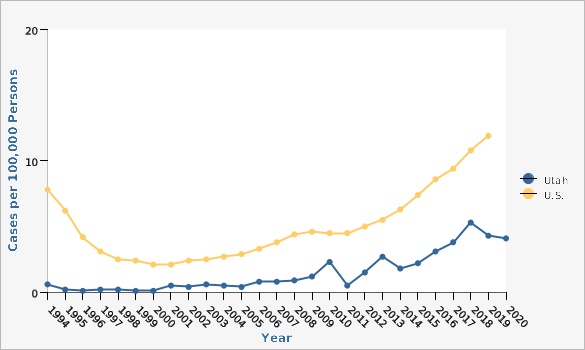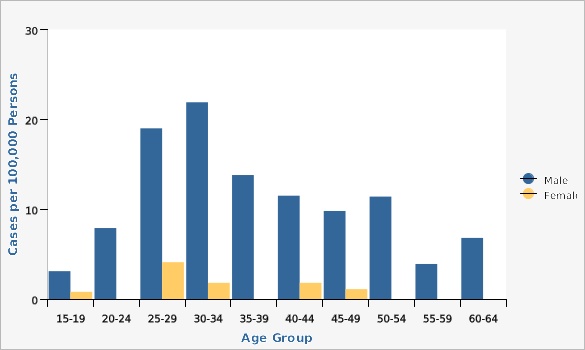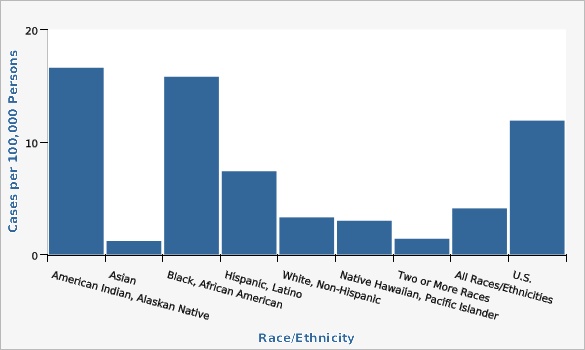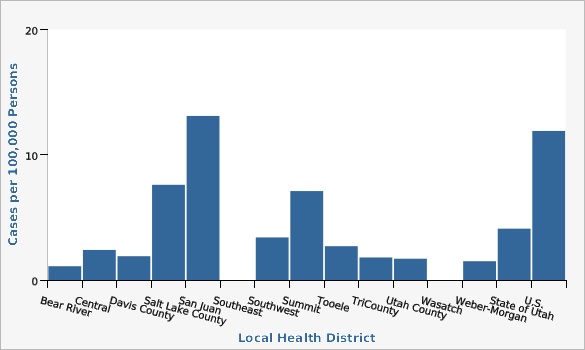Complete Health Indicator Report of Syphilis Cases - Primary and Secondary
Definition
Rate of newly reported cases of primary and secondary syphilis by date of diagnosis per 100,000 persons.Numerator
Number of newly reported cases of primary and secondary syphilis by date of diagnosis.Denominator
Total Utah population.Data Interpretation Issues
Reported primary and secondary syphilis rates are calculated by dividing the number of cases within the population of interest by the total number of persons within that population, then multiplying by 100,000. It should be noted that because of the relatively small number of primary and secondary syphilis infections reported in Utah, rates can be volatile: a small change in the number of cases can noticeably change the rate. This change may look significant, but, statistically, it may not be. Caution is strongly recommended when interpreting small case numbers and rates.Why Is This Important?
Syphilis is a complex sexually transmitted disease (STD) caused by the bacterium ''Treponema pallidum'' (spp. ''pallidum''). The initial stage (primary syphilis) is characterized by a highly infectious painless open sore, called a chancre, at the site of infection. Chancres occur mainly on the external genitals, vagina, anus, or in the rectum. Syphilis is passed from person to person through direct contact with the chancre. Sexual transmission can also occur during the secondary stage of syphilis. An infant can acquire syphilis through the placenta if the mother is infected. In later stages of the disease, the bacteria move throughout the body, damaging many organs over time. The open nature of the syphilitic sores makes it easier to acquire HIV, if exposed, or to transmit the virus, if infected. Public health intervention and education measures are crucial in eliminating syphilis.Healthy People Objective STD-7:
Reduce sustained domestic transmission of primary and secondary syphilisU.S. Target: Not applicable, see subobjectives in this category
Other Objectives
Related HP2020 Objectives include:[[br]] [[br]] =====Healthy People Objective STD-7:===== Reduce sustained domestic transmission of primary and secondary syphilis * {{style color:#003366 STD-7.1:}} Reduce domestic transmission of primary and secondary syphilis among females [[br]]'''U.S. Target:''' 1.3 new cases per 100,000 population * {{style color:#003366 STD-7.2:}} Reduce domestic transmission of primary and secondary syphilis among males [[br]]'''U.S. Target:''' 6.7 new cases per 100,000 population[[br]] [[br]] =====Healthy People Objective STD-8:===== Reduce congenital syphilis[[br]] '''U.S. Target:''' 9.6 new cases per 100,000 live birthsHow Are We Doing?
In 2020, 133 cases of primary and secondary (P&S) syphilis were diagnosed and reported in Utah. Sixty-six of the cases were primary syphilis and Sixty-seven cases were secondary syphilis. Although P&S syphilis rates have fallen for two years now, 18.9% in 2019 and 4.7% in 2020, the general trend of the past 15-years has been one of general increase. In 2020 the rate of P&S syphilis was 925.0% higher than in 2005. During 2020, 83.5% of P&S syphilis cases were diagnosed among residents within the Wasatch Front (Salt Lake, Davis, Utah, and Weber Counties); which is consistent with recent years. Although most cases are reported from Utah's more populous counties, San Juan County Health District had the highest rate of P&S syphilis at 13.1 cases per 100,000 persons. P&S syphilis cases were primarily diagnosed among men during 2020 at a rate of 7.4 cases per 100,000 male persons. Males between the ages of 30-34 years actually experienced the highest rates in 2020 (21.9 cases per 100,000 people). Twelve females were diagnosed with P&S syphilis in 2020. Only 67 females have been reported with P&S syphilis from 2000-2020, meaning that 35.8% of all P&S syphilis cases among females occurred between 2019-2020. During 2020, the P&S syphilis cases were diagnosed primarily among White, non-Hispanic individuals (61.7%) followed by Hispanics (26.3%).How Do We Compare With the U.S.?
P&S syphilis rates in Utah have consistently been lower than rates in the U.S., although Utah has experienced several increases in recent years. The overall 2019* rate for P&S syphilis in the U.S. was 11.9 cases per 100,000 persons, compared to 10.8 cases per 100,000 in 2018. Nationally in 2019*, rates were highest among males aged 25 to 29 (57.6 cases per 100,000 persons). Males had a significantly higher rate than females: 20.1 cases per 100,000 males as compared to 3.9 cases per 100,000 females (CDC. [https://www.cdc.gov/std/statistics/2019/tables/34.htm ''Sexually Transmitted Disease Surveillance''], 2019). *At the time of writing, U.S. STD Surveillance Data for 2020 was not yet available.What Is Being Done?
Persons who test positive for syphilis are confidentially interviewed by a local public health nurse to educate the patient, ensure proper treatment, and to obtain sexual partner information for follow-up. This process potentially prevents those diseases reported from being spread and from the patient becoming reinfected. The Centers for Disease Control and Prevention recommendations for testing, treatment, and follow-up are adhered to by the Utah Department of Health and the local health departments. The Utah Department of Health HIV and STD Prevention and Surveillance Program, along with local health departments, currently provides STD presentations upon request to a variety of organizations, agencies, and facilities.Available Services
The Utah Minor's Consent Law allows adolescents between the ages of 14 and 17 years to be tested and treated for an STD without the consent of a parent. Therefore teens are able to utilize clinics available to them confidentially. Many local health districts have STD clinics located at their local health department where adolescents can be tested and treated for STDs at minimal or no cost. Planned Parenthood has locations throughout Utah that also provide STD services at minimal cost. Condoms are also available at these locations. STD presentations are available through the Utah Department of Health upon request. The Utah Department of Health also has educational pamphlets available.Related Indicators
Relevant Population Characteristics
Although the vast majority (83.5%) of P&S cases are diagnosed among residents within the Wasatch Front (Salt Lake, Davis, Utah, and Weber Counties); in 2020, San Juan County Health District had the highest rate of P&S syphilis at 13.1 cases per 100,000 persons. In 2020, P&S syphilis cases were primarily diagnosed among men (91.0%), with men aged 30 to 34 experiencing the highest rate of P&S syphilis (21.9 cases per 100,000 persons). The majority of cases (61.7%) were White, non-Hispanic.Related Relevant Population Characteristics Indicators:
Health Care System Factors
Syphilis is the target of a nationwide elimination effort.Related Health Care System Factors Indicators:
Risk Factors
Risk factors for sexually transmitted diseases include: * sexual activity among young adults 25 and younger * multiple sex partners * prior history of STDs * unprotected sex * sexual contact with prostitutes (male or female) * illicit drug use[[br]] [[br]] Those who fall within one or more of these categories should be tested for STDs in regular intervals. Sites of primary syphilis infection may include penis, rectum, anus, vagina, cervix, vulva, or mouth.Related Risk Factors Indicators:
Health Status Outcomes
Elimination of syphilis will aid in the fight against HIV, as the open nature of the syphilitic sores makes it easier to acquire HIV, if exposed, or to transmit the virus, if infected. Public health intervention and education measures are crucial in eliminating syphilis.Related Health Status Outcomes Indicators:
Graphical Data Views
Primary and Secondary Syphilis, Utah and U.S., 1994-2020

| Utah vs. U.S. | Year | Cases per 100,000 Persons | ||||
|---|---|---|---|---|---|---|
Record Count: 53 | ||||||
| Utah | 1994 | 0.6 | ||||
| Utah | 1995 | 0.2 | ||||
| Utah | 1996 | 0.1 | ||||
| Utah | 1997 | 0.2 | ||||
| Utah | 1998 | 0.2 | ||||
| Utah | 1999 | 0.1 | ||||
| Utah | 2000 | 0.1 | ||||
| Utah | 2001 | 0.5 | ||||
| Utah | 2002 | 0.4 | ||||
| Utah | 2003 | 0.6 | ||||
| Utah | 2004 | 0.5 | ||||
| Utah | 2005 | 0.4 | ||||
| Utah | 2006 | 0.8 | ||||
| Utah | 2007 | 0.8 | ||||
| Utah | 2008 | 0.9 | ||||
| Utah | 2009 | 1.2 | ||||
| Utah | 2010 | 2.3 | ||||
| Utah | 2011 | 0.5 | ||||
| Utah | 2012 | 1.5 | ||||
| Utah | 2013 | 2.7 | ||||
| Utah | 2014 | 1.8 | ||||
| Utah | 2015 | 2.2 | ||||
| Utah | 2016 | 3.1 | ||||
| Utah | 2017 | 3.8 | ||||
| Utah | 2018 | 5.3 | ||||
| Utah | 2019 | 4.3 | ||||
| Utah | 2020 | 4.1 | ||||
| U.S. | 1994 | 7.8 | ||||
| U.S. | 1995 | 6.2 | ||||
| U.S. | 1996 | 4.2 | ||||
| U.S. | 1997 | 3.1 | ||||
| U.S. | 1998 | 2.5 | ||||
| U.S. | 1999 | 2.4 | ||||
| U.S. | 2000 | 2.1 | ||||
| U.S. | 2001 | 2.1 | ||||
| U.S. | 2002 | 2.4 | ||||
| U.S. | 2003 | 2.5 | ||||
| U.S. | 2004 | 2.7 | ||||
| U.S. | 2005 | 2.9 | ||||
| U.S. | 2006 | 3.3 | ||||
| U.S. | 2007 | 3.8 | ||||
| U.S. | 2008 | 4.4 | ||||
| U.S. | 2009 | 4.6 | ||||
| U.S. | 2010 | 4.5 | ||||
| U.S. | 2011 | 4.5 | ||||
| U.S. | 2012 | 5.0 | ||||
| U.S. | 2013 | 5.5 | ||||
| U.S. | 2014 | 6.3 | ||||
| U.S. | 2015 | 7.4 | ||||
| U.S. | 2016 | 8.6 | ||||
| U.S. | 2017 | 9.4 | ||||
| U.S. | 2018 | 10.8 | ||||
| U.S. | 2019 | 11.9 | ||||
Data Notes
Rates were calculated by dividing the number of cases for each year by the total population within that year and multiplying by 100,000. At the time of writing, U.S. STD Surveillance Data for 2020 was not yet available.Data Sources
- The Utah Department of Health and Human Services Bureau of Epidemiology
- Population Estimates: National Center for Health Statistics (NCHS) through a collaborative agreement with the U.S. Census Bureau, IBIS Version 2020
- National Center for HIV, STD, and TB Prevention, Centers for Disease Control and Prevention
Primary and Secondary Syphilis by Age and Sex, Utah, 2020

| Males vs. Females | Age Group | Cases per 100,000 Persons | ||||
|---|---|---|---|---|---|---|
Record Count: 20 | ||||||
| Male | 15-19 | 3.1 | ||||
| Male | 20-24 | 7.9 | ||||
| Male | 25-29 | 19.0 | ||||
| Male | 30-34 | 21.9 | ||||
| Male | 35-39 | 13.8 | ||||
| Male | 40-44 | 11.5 | ||||
| Male | 45-49 | 9.8 | ||||
| Male | 50-54 | 11.4 | ||||
| Male | 55-59 | 3.9 | ||||
| Male | 60-64 | 6.8 | ||||
| Female | 15-19 | 0.8 | ||||
| Female | 20-24 | 0.0 | ||||
| Female | 25-29 | 4.1 | ||||
| Female | 30-34 | 1.8 | ||||
| Female | 35-39 | 0.0 | ||||
| Female | 40-44 | 1.8 | ||||
| Female | 45-49 | 1.1 | ||||
| Female | 50-54 | 0.0 | ||||
| Female | 55-59 | 0.0 | ||||
| Female | 60-64 | 0.0 | ||||
Data Notes
Rates were calculated by dividing the number of cases within each age/gender group by the total population in that group and multiplying by 100,000.Data Sources
- The Utah Department of Health and Human Services Bureau of Epidemiology
- Population Estimates: National Center for Health Statistics (NCHS) through a collaborative agreement with the U.S. Census Bureau, IBIS Version 2020
Primary and Secondary Syphilis Rates by Race and Ethnicity, Utah, 2020

| Race/Ethnicity | Cases per 100,000 Persons | |||||
|---|---|---|---|---|---|---|
Record Count: 9 | ||||||
| American Indian, Alaskan Native | 16.6 | |||||
| Asian | 1.2 | |||||
| Black, African American | 15.8 | |||||
| Hispanic, Latino | 7.4 | |||||
| White, Non-Hispanic | 3.3 | |||||
| Native Hawaiian, Pacific Islander | 3.0 | |||||
| Two or More Races | 1.4 | |||||
| All Races/Ethnicities | 4.1 | |||||
| U.S. | 11.9 | |||||
Data Notes
Rates were calculated by dividing the number of cases within a race/ethnicity group by the population in that group and multiplying by 100,000.Data Sources
- The Utah Department of Health and Human Services Bureau of Epidemiology
- Population Estimates by Age, Sex, Race, and Hispanic Origin for Counties in Utah, U.S. Bureau of the Census, IBIS Version 2020
Primary and Secondary Syphilis by Local Health District, Utah, 2020

| Local Health District | Cases per 100,000 Persons | |||||
|---|---|---|---|---|---|---|
Record Count: 15 | ||||||
| Bear River | 1.1 | |||||
| Central | 2.4 | |||||
| Davis County | 1.9 | |||||
| Salt Lake County | 7.6 | |||||
| San Juan | 13.1 | |||||
| Southeast | 0.0 | |||||
| Southwest | 3.4 | |||||
| Summit | 7.1 | |||||
| Tooele | 2.7 | |||||
| TriCounty | 1.8 | |||||
| Utah County | 1.7 | |||||
| Wasatch | 0.0 | |||||
| Weber-Morgan | 1.5 | |||||
| State of Utah | 4.1 | |||||
| U.S. | 11.9 | |||||
Data Notes
Rates were calculated by dividing the number of cases within a local health district by the total population in that district and multiplying by 100,000. At the time of writing, U.S. STD Surveillance Data for 2020 was not yet available. U.S. rates shown in the above data table reflect 2019 U.S. STD Surveillance DataData Sources
- The Utah Department of Health and Human Services Bureau of Epidemiology
- Population Estimates: National Center for Health Statistics (NCHS) through a collaborative agreement with the U.S. Census Bureau, IBIS Version 2020
- National Center for HIV, STD, and TB Prevention, Centers for Disease Control and Prevention
Primary and Secondary Syphilis by Local Health District, Utah, 2020

References and Community Resources
Fact sheets for communicable diseases may be found on the Bureau of Epidemiology website [https://epi.health.utah.gov/a-list/]. STD resources and reports are available on the Bureau of Epidemiology Prevention, Treatment, and Care Programs website [https://ptc.health.utah.gov/prevention/std/]. Other STD resources are available on the Bureau of Epidemiology website [http://health.utah.gov/epi/prevention/]. Screening Guidelines [https://www.cdc.gov/std/treatment-guidelines/screening-recommendations.htm]. Centers for Disease Control and Prevention, Division of Sexually Transmitted Disease Prevention website [https://www.cdc.gov/std/default.htm]. Centers for Disease Control and Prevention. ''Sexually Transmitted Disease Surveillance 2019''. Atlanta: U.S. Department of Health and Human Services; 2019. [https://www.cdc.gov/std/statistics/2019/default.htm]. Centers for Disease Control and Prevention. Sexually Transmitted Infections Treatment Guidelines 2021 [http://www.cdc.gov/std/treatment].More Resources and Links
Evidence-based community health improvement ideas and interventions may be found at the following sites:- Centers for Disease Control and Prevention (CDC) WONDER Database, a system for disseminating public health data and information.
- United States Census Bureau data dashboard.
- Utah healthy Places Index, evidence-based and peer-reviewed tool, supports efforts to prioritize equitable community investments, develop critical programs and policies across the state, and much more.
- County Health Rankings
- Kaiser Family Foundation's StateHealthFacts.org
- Medical literature can be queried at PubMed library.
Page Content Updated On 10/20/2021,
Published on 11/10/2022
